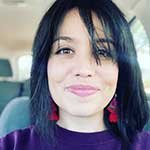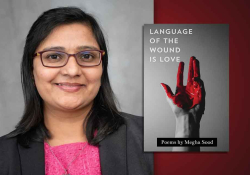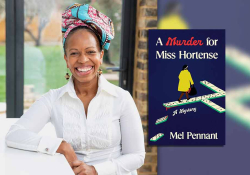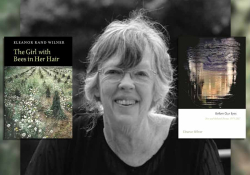Opening the Doorways of Recognition for Native People: A Conversation with Joy Harjo
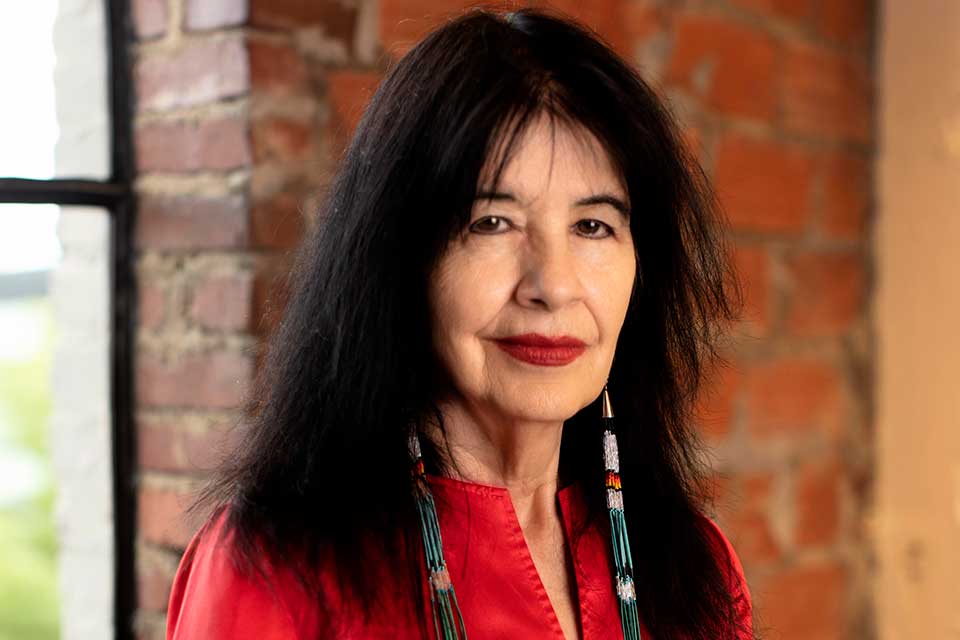
For the 44th Annual Writers Week, the University of California, Riverside Department of Creative Writing, in partnership with the LA Review of Books, honored three US Poets Laureate with Lifetime Achievement Awards: Rita Dove (1993–95), Juan Felipe Herrera (2015–16), and Joy Harjo (2019–present). As part of honoring these poetry luminaries—three visionaries representing barrier breakage in their page, stage, and community work—Crystal AC Salas, third-year MFA student at UCR, interviewed each laureate over phone and Zoom in commemoration of the occasion.
To celebrate the twenty-fifth anniversary of National Poetry Month, in this last of the series of conversations with three US Poets Laureate, Joy Harjo discusses her digital map project, how Native people have been disappeared, and answers the question, What can poetry do?
Crystal AC Salas: Who would you say are your ancestors in your legacy of poet as ambassador, community organizer, and activist? How are these ancestors present in your work with the public?
Joy Harjo: June Jordan is a poet whose scope and presence encompasses all those terms. She’s not quite an ancestor, but she is almost a generation ahead of me. I met her first through her book of poetry Things That I Do in the Dark. Her activism was always the bedrock of any utterance from her, whether it was poetry or personal essay—her essays are wonderful. I remember when she started that Poetry for the People project—a project that shifted poetry from behind doors in the university to more of an open-door policy, so that poetry had its proper place in the community. She was brave and courageous and understood that poetry is essentially the lifeblood of people, of cultures. She went about in her work with the Poetry for the People project, too, to return poetry to the people in a way that it is present and living and moving about in countries all over the world . . .
Of course, there are many other ancestors with quite a reach in generation, culture, and country. In my elementary, junior high, and high school classes we read mostly poets from New England and England, mostly male from the late nineteenth century to the early twentieth century. Langston Hughes surfaced now and then, but there were no Native poets. There was no awareness of them at all. I came of age as a poet in the very late 1970s and into the ’80s as a student at the University of New Mexico. I was lucky to be caught up in the wave of multicultural poetry awareness. One of the people who fostered that multicultural literary movement, who was very important to many of us, was the novelist Ishmael Reed. I met him when Leslie Silko brought him to the university during the brief time she taught there. It wasn’t long after that he started the Before Columbus Foundation to foster a more equitable scope of American poetry.
Another ancestor or inspiration is Wilma Mankiller, the Cherokee chief, who returned home to Oklahoma to work in her grassroots, traditional community. She had been living in the Bay Area for some time before moving home. Her family had left northeastern Oklahoma and gone west as part of the US government’s Relocation Program, a program instituted to lure Natives from their reservations with the intent to destroy Native families by acculturating them to becoming full-fledged Americans and loosen their hold on culture and the land. She inspired me to return home to my root community here. There is often such a deep cultural divide between those far away in the urban and academic communities, and those who are holding down the culture and lands in their home communities. Mankiller’s work bridged many communities.
When I began writing poetry, I went to look at other tribal, Indigenous nations to see how they wrote, because I was looking more for that kind of orality, and I was inspired by many African poets and writers. Especially Okot p’Bitek—I write a short tribute to him in my next memoir, which will be out in September, called Poet Warrior (W.W. Norton). His book of poetry Song of Lawino was also a confirmation, a doorway, and an inspiration. One of the highlights of my life is getting to meet him in the late 1970s at a conference in Amsterdam. I got to thank him and shake his hand.
One of my highlights of this last year was getting to talk to Wayne Shorter on the phone. Because his work has accompanied me all the way, his brilliance reaches out in concentric circles.
I think of Cesar Chavez, Bob Marley, Lila Downs, and John Coltrane. I don’t equate myself with them, but these are people I admire for their bravery and gifts, people who have inspired me and from whom I have gained strength as they stood up and stepped up, and were pioneers in their respective fields. Of course, Martin Luther King Jr. as a humanitarian, a carrier of justice. We’re all here as one—essentially earth is a person. We’re all here together, but diversity is what gives us the flavor, the energy, the beauty of earth.
We’re all here together, but diversity is what gives us the flavor, the energy, the beauty of earth.
Salas: What was your understanding of the US Poet Laureate position prior to your appointment, and how did this evolve over your term? Furthermore, could you speak to your process of approaching your central project of your laureateship? What surprised you to learn about the accessibility of resources for poetry programming?
Harjo: I knew that it was an honorary position and that some poets were very active in that position. The post used to be the Poet Consultant in the Library of Congress until the title was changed in the late 1960s to US Poet Laureate. The position is a Library of Congress position, and the head librarian of Congress appoints the poet laureate. I am proud to say I was appointed by Dr. Carla Hayden, an Obama appointee. I like thinking of Gwendolyn Brooks, who used to have a desk there at the Library of Congress. I think Natasha Trethewey also used to keep some hours there at the desk. There is a desk and an office. Before the Covid pandemic, I visited the office and set the desk up, however, I live too far away to keep hours but have been thinking of trying to do so virtually.
Rita Dove’s appointment marked a shift in the activism of the post. She used the position to actively engage the American public in poetry. Since then, many of the appointees were very active and created projects, including Robert Pinsky, Billy Collins, Natasha Trethewey, Juan Felipe Herrera, and Tracy K. Smith. I see myself as a poetry ambassador. Every laureate has made the position uniquely their own.
I am the first Native poet, which was quite a ground-breaking appointment. Many Americans believe, according to studies commissioned by Illuminative, that Natives do not exist anymore in this country, or if we do exist we are not visible because we do not look like the stereotypes. My grandmother played saxophone in Indian Territory before Oklahoma statehood. She was also a painter with a BFA in studio art. I always say, put that in your collection of Native images. So to have a Native woman named in one of the most recognizable positions for a poet to occupy in this country is quite astounding. Suddenly, we do exist, and there are over 570 Native Nations, and some of us are poets. There are many Native poets. We are human beings.
Everyone has made the position their own, and by nature of being the first Native poet, I have opened the doorways of recognition for Native people. When it was announced I was the new poet laureate, Native people were so proud. The position was about them. It lifted up our communities. It was similar to Deb Haaland and Sharice Davids becoming two of the first Native Congresswomen. And now Deb has been nominated to be secretary of the interior. We don’t usually see Native people at the national table on anything. We’ve been essentially disappeared, even though the whole of the Western Hemisphere is Indian Country.
We’ve been essentially disappeared, even though the whole of the Western Hemisphere is Indian Country.
Yet, in this country, we’re rarely seen in contemporary cultural events. We are almost never represented in literary circles. Layli Long Soldier and Natalie Diaz winding up on the shortlist for the National Book Awards was a first in a long time for any Native poet to make the top book award lists. (I think only Linda Hogan had been so recognized, over twenty years ago.) We’re still disappeared in the culture. For us to be seen, to be acknowledged, means that there is a buried, denied history, and to recognize it means that the whole story of America will have to be reconstructed.
I consider the laureateship as a position of service. I consider the president, the vice president, any position in our living, whatever we do, as positions of service.
I work with an excellent team over at the Library of Congress headed by Rob Casper. Even before the laureateship was announced, we immediately went to work on my project. I wanted to highlight contemporary Native poets and how we still occupy place literally and metaphorically in America and the Western Hemisphere. And I wanted to work with the Library of Congress’s many departments. When I went in for orientation for the position, I asked to tour and visit the different departments and programs that make up the Library of Congress. I have always loved geography and maps, so that was one of the first stops, and also the Folklife Center where I got to hear some Mvskoke songs recorded early last century. They are now an important part of my project, Living Nations, Living Words: First Peoples Poetry.
We made a digital map on which contemporary Native poets are highlighted. Because it is digital, it is easily available to anyone with internet access. A Norton anthology of the digital mapping project will be published this May. I choose a map with no political demarcations. We see blue and green: land and water. The perspective shifts dramatically. And we hear the voices of Native poets read their original poems and talk about place. I would like to expand the map to the whole globe and include every living poet on this digital map, but there’s the capacity question. How much staffing would that take? How much time? How much funding?
We are at work on a teacher’s guide for the project right now. I imagine a digital map of generational contributions to poetry that would circle the globe. And then we’d map generations of poets. A generation is an entity, an energetic equation, similar to a horizontal kind of person that goes across and all around the world. Every generation has a certain energy. I was thinking, too, about how the poetry ancestor map would be more vertical in direction.
This question also makes me think of the pandemic and makes me think of the response of organizations to artists and to poets at a time when everyone, suddenly, as the country shut down and we were isolated, we didn’t know what was going to happen. We had never experienced anything quite like this. Certainly, other generations had experienced pandemics, like the Spanish Flu epidemic, and epidemics wiped out close to half the Indigenous populations of the Americas. With the Covid pandemic, people came to poetry to find a refuge, a place for the unanswerable, for grief and inspiration. Poetry is spiritual food. In the sense that we’re all spiritual beings . . . just as we need food for our bodies and our minds, we need food to feed our spirits.
With the Covid pandemic, people came to poetry to find a refuge, a place for the unanswerable, for grief and inspiration.
Salas: After Amanda Gorman’s riveting performance at the presidential inauguration, many folks seemed shocked that such a young person could write and perform with such powerful articulation. Personally, as someone who works with youth, while I was in awe of her performance, I was not at all surprised by the keenness of vision that has arrived at her young age. What were some of your favorite insights to arise about the potential of poetry that came from working with children and younger poets?
Harjo: I have taught intermittently through the years—when I began teaching it was full-time, then to have time for my art I went to half-time, then now and then I needed total time off from it. I have come to see that teaching itself is an art that involves accumulated knowledge in the field, continual education, performance, and leadership. It is demanding and at the same time enriching at all levels.
When I was an undergraduate at the University of New Mexico, my poetry professor, Gene Frumkin, took some of his students to local elementary, junior, and high schools to teach poetry in the New Mexico Poetry in the Schools Program. I remember looking so young, I’d be asked for my hall pass! When I first stood in front of a class, I was terrified—I was pretty shy then—but it taught me to focus on what I was doing. To see how poetry inspired and gave the students tools they could use through their lives kept me at it. After graduate school, I pieced together Poetry in the Schools gigs to make a living.
I learned much in those classrooms. I learned about leadership. Some were so happy to be present and learn about poetry. Their students were well behaved and open. Other teachers were like “Oh, thank God, you’re here, now I can leave!” Those classes would start off rowdy because I wasn’t introduced, was essentially a substitute. With poetry, though, I could catch them. Those classes where I was warned by the teacher, “This is my worst class,” were usually the best classes. Poetry gave them a way to speak that they may not have found before in a classroom setting. Poetry created a door in the realm of creativity in which they were allowed to be who they were without criticism and expectation. I was reminded of my own childhood and how much I loved art classes because I could set my imagination free. That was my first venture into teaching. Bullshit doesn’t work. You have to be real. And it’s about respect.
My last position as the chair of excellence at the University of Tennessee was the best teaching experience of my teaching career. I was embraced by the department and the students. I was enabled and supported in my teaching and service and gave back in return. In some of my positions this was mostly so, but in the last few positions the conditions and atmosphere in which I was hired were unstable or unsupportive of creative writing or Native hires. One of the hardest lessons of my own failing came when I was teaching in the English department at UCLA. My appointment was split between English and American Indian Studies. The line for my hire was in English. During the hiring process, the department gave the American Indian literature line up for a different position, a medieval literature position, AIS got caught having to pay for the hire, and they had to essentially rent me out to English. At the same time, I was caught in the middle of a political war in AIS, one not of my doing. And in English I experienced pushback because I was a Native female poet and not a white male academic. There was an antimulticultural backlash whipping through the underground. I’d have to walk through notes of protest that people like me were teaching to get to my classroom. My teaching changed. I grew uptight and distrusted my own cultural structuring for my courses.
Once during office hours, a creative writing student brought a visiting friend of hers because her friend loved my poetry and wanted to meet me. After the introductions my student turned to her friend and said, “I wish she taught the same way that she wrote poetry.” Though it was painful to hear that, it was exactly what I needed to hear. I had gotten off track and had begun to lose myself to the politics of settler correctness. My poetry comes from a fierce, honest, and compassionate field in the imagination. It is my teacher.
However, that may not have answered your questions. Poetry gives any student a tool or tools to navigate the labyrinths of human experience. Those tools last a lifetime.
My poetry comes from a fierce, honest, and compassionate field in the imagination. It is my teacher.
Salas: We are in a time of renewed investment in activism, where we are also hopefully asking about the ethics of these gestures and our positionalities in offering service in ways that are sensitive to and even desired by the communities we seek to uplift. As a literary activist and ambassador, how do you stay checked in with that concern? What questions do you ask yourself?
Harjo: I think it’s the advice I give to people who want to come to a Native community: you come in as a human being, you treat people like human beings; just be yourself, and don’t take away what doesn’t belong to you. Many come to the communities wanting to assuage guilt, to lose themselves, or to even take on a different identity. Maybe friendship is the best mode. And if a friend needs help, then they ask for it with each other. It is not forced or unasked.
There was a period when I met many young white women students after my performances at their universities, who would come up and excitedly tell me how they were heading up to Pine Ridge during spring break or the summer, to help. I would speak to them with concern and compassion because I knew the trouble they could get into and the trouble they could make. None of them listened. They were caught up in a Wild West story in which they could meet colorful warriors, fix dire poverty, and save a people, when they were the ones trying to save themselves. Mostly their intentions were well placed, just ill-begotten.
The bottom line is respect between all of us. And it’s important to listen. By listening, you’ll hear what’s being said, but if you listen really closely, you’ll hear what’s not being said. Be respectful—that’s the advice I give to people coming into a Native community. I like the way one academic community dealt with this, and with the problem of universities pumping out degrees in Native-related fields, graduating students who never met and most likely would never meet the communities they were studying or using for their degrees. I was an artist in residence for a few weeks in British Columbia at the First Nations Longhouse at the University of British Columbia—they have a Native studies group there. They actively involve the Native community that is the keeper of the lands on which the university is situated. Students in the Native studies programs take their academic work to the reserve and present it in the community. It makes people accountable. It’s a give-back model of studying and working. I remember when teaching, I would always ask the students, if they were in a Native or Indigenous studies class, “Okay, how is this research going to impact the community? Is it going to make a difference?”
Salas: The concept of a public mandate for an arts ambassador on a county, state, and/or national level has always fascinated me within our nation—it’s a notable contrast in a culture in which to be an American artist is to constantly have the societal legitimacy of one’s artmaking under siege. Furthermore, to be a BIPOC artist is often to endure the added complexity of the dominant culture’s dismissal of one’s personhood and lived experience alongside their art. And so, the national and institutional endorsement of a poet as a necessary ambassador within the republic has always made me curious about both the joys and the precarities of the post. How did/do you reconcile the promise of this post within the devaluation of art and humanities within our racist and capitalistic culture?
Harjo: Your very large question encompasses a paradox that is not easily answerable in a short response. Artists of all sorts live outside the center, yet we are the keepers of imagination that will keep the spirit of this country vibrant. Add to that the “BIPOC” (I’m not really vibing with that term yet as it feels contrived) presence/offerings/shift and you have an outside-outside. Yet it is especially the outsider cultural influencers that are shifting and enlivening the cultural stream. Any of us nonmainstream artists and poets of color coming up through various writing programs or just writing within an American literary community have many stories of our struggles that can be turned into empowerment narratives. The struggles are a constant. And then if you are Indigenous or Native, you usually don’t exist at all in the narrative. There is a caste system at work here even in the literary world.
I was speaking with a young Native poet last night who is working on a memoir, and as I’m answering this question, I’m thinking about her. “What would I tell her?” Ultimately, it comes down to that you have to deal with it at the utter, intimate center of yourself first. And grow that courage and that strength and the belief in who your people are, who you are, and to honor what you were put here to do and these gifts you were given to develop and share. It starts there. We don’t see ourselves in the American mirror. We’re not usually represented. We have to honor our own classic traditions, which are not Greek and Roman, even as we have to become familiar with the overculture.
It’s like learning different languages. We have to know our value and know that we bring value to this story we are all making together. The mainstream isn’t always happy with being shifted. It’s like a huge ocean with rivers, many rivers feeding it, distributing it, and nourishing it. We each add to the story. And as in any story, any lie will eventually show itself, any deceit, any falsity is uncovered. This country is young, essentially an adolescent: “it’s only about me and the time is now.” The arts, the essence of arts is eternal. There’s no past, present, or future. As I/we move about . . . I/we just have to listen deeply and respect and just keep moving.
We don’t see ourselves in the American mirror. We’re not usually represented.
Salas: What have been your observations about the role of poetry and its role in the community consciousness when the nature of public space has changed so drastically? What are your hopes for the role of poetic community engagement as the nation returns, not to “normal,” but resumes in a time of reckoning with the grief and post-trauma of its most recent events?
Harjo: It’s interesting that you say “post-trauma,” because as excited as I was to see a shift in leadership, I felt almost depression, as if I were in an abusive situation for which there was no way out, then rescued, and in the aftermath of PTSD resonance. I try to feel compassion. . . . There’s a belief that carries a destructive and racist story. Someone gains power from it, money. It all comes around to common sense. And then the massive pandemic brings so much separation, sickness, and death. Here in our community, we’ve lost major culture bearers to Covid. We Natives haven’t historically fared very well under pandemics. And it’s decimating our populations again. And then I ask, What can poetry do? Poetry tells me that it goes into those places that nothing else can reach. You can carry it anywhere. During this time, we haven’t been able to attend live poetry readings, live music, or other venues where we meet together to experience artistic expression. A concert, even an art show is almost ritualistic. We experience together. Poetry is more vibrant there. So are we.
February 2021
Author’s note: Crystal AC Salas is grateful to the poets laureate for their graciousness of time and wisdom and Professors Allison Hedge Coke and Sara Borjas, as well as her colleague Abbie Reese, for their guidance and assistance on this project.

Joy Harjo’s nine books of poetry include Conflict Resolution for Holy Beings, How We Became Human: New and Selected Poems, 1975–2001, and She Had Some Horses. Harjo’s memoir Crazy Brave won several awards, including the PEN USA Literary Award for Creative Nonfiction and the American Book Award. She co-edited two anthologies of contemporary Native women’s writing: When the Light of the World Was Subdued, Our Songs Came Through and Reinventing the Enemy’s Language: Native Women’s Writing of North America, one of the London Observer’s Best Books of 1997. She is the recipient of the Ruth Lilly Prize from the Poetry Foundation for Lifetime Achievement, the 2015 Wallace Stevens Award from the Academy of American Poets for proven mastery in the art of poetry, a Guggenheim Fellowship, the William Carlos Williams Award from the Poetry Society of America, and the United States Artist Fellowship. In 2014 she was inducted into the Oklahoma Writers Hall of Fame. A renowned musician, Harjo performs with her saxophone nationally and internationally, solo and with her band, the Arrow Dynamics. She has five award-winning CDs of music, including the award-winning album Red Dreams, A Trail Beyond Tears, and Winding through the Milky Way, which won a Native American Music Award for Best Female Artist of the Year in 2009. Harjo’s latest is a book of poetry from Norton, An American Sunrise. In 2019 Harjo was appointed the 23rd United States Poet Laureate, the first Native American to hold the position. Her poem “Somewhere” appears in the “Redreaming Dreamland” issue of WLT, which reflects on the centennial of the Tulsa Race Massacre. She lives in Tulsa, Oklahoma.
